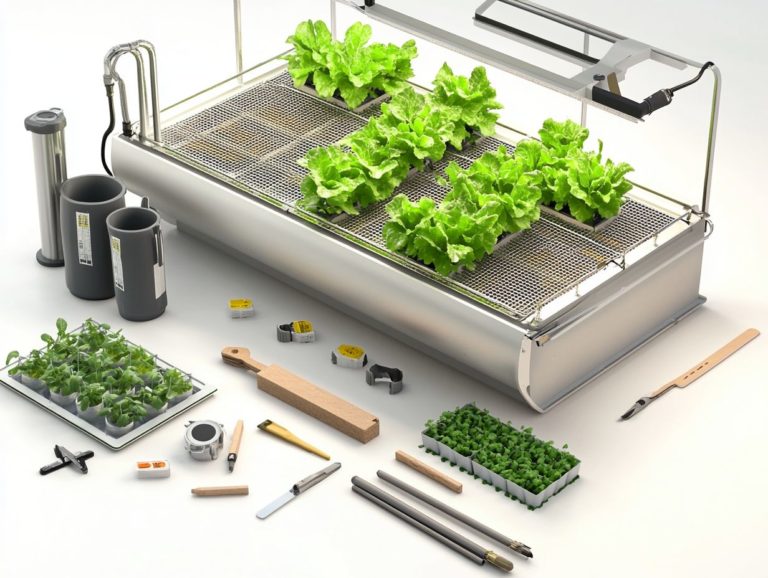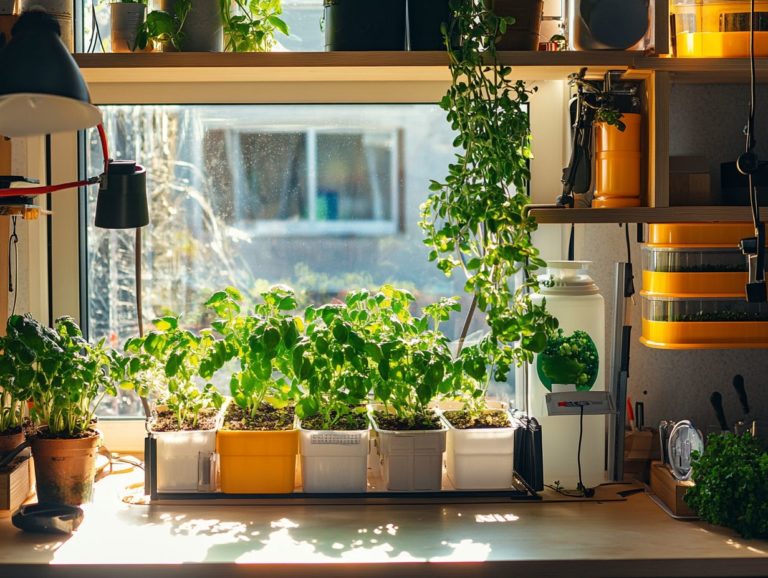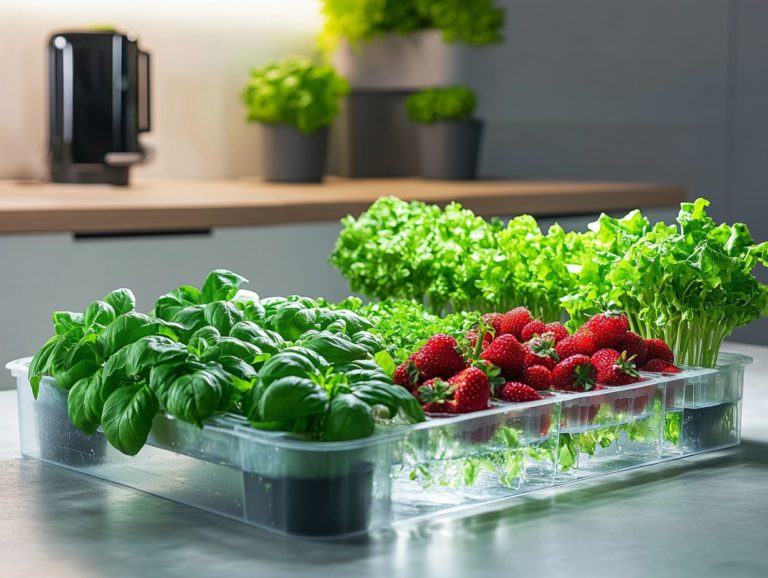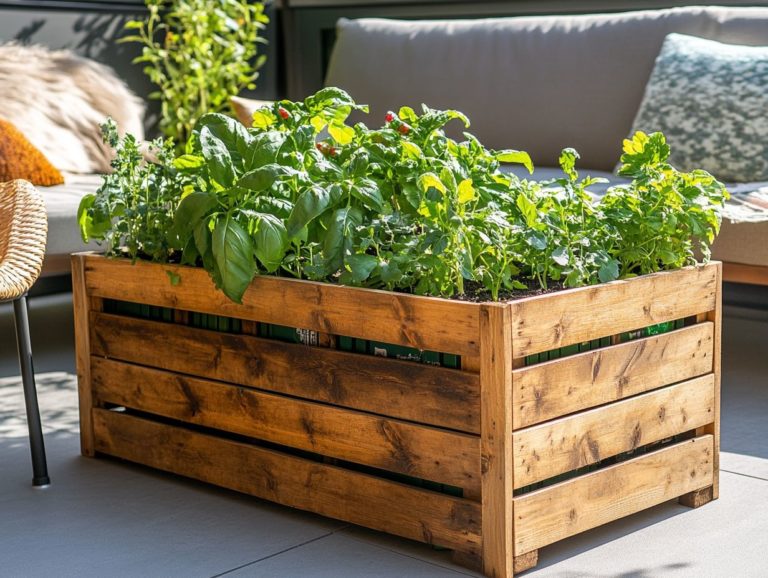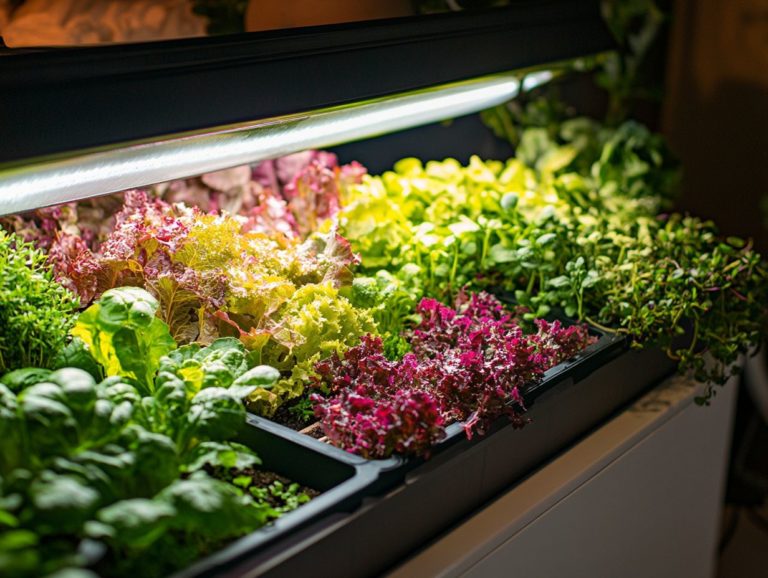10 Creative DIY Hydroponic Ideas for Your Home
Are you prepared to turn your living space into a lush green oasis? Hydroponic gardening presents a distinctive opportunity to cultivate plants without the need for soil, making it perfect for those with limited space or resources. Embrace the future of gardening!
Contents
- Essential Tips for Your Hydroponic Garden:
- 1. Vertical PVC Pipe Garden
- 2. Mason Jar Herb Garden
- 3. Window Farming
- 4. Hanging Bottle Garden
- 5. Wooden Pallet Garden
- 6. Recycled Plastic Bottle Garden
- 7. Shoe Organizer Hydroponic System
- 8. Rotating Tower Garden
- 9. Floating Raft System
- 10. Aquaponics System
- How Does Hydroponic Gardening Work?
- Frequently Asked Questions
- What are hydroponic systems and why are they beneficial for home gardening?
- What are some easy DIY hydroponic ideas for beginners?
- What materials do I need to create a simple hydroponic system at home?
- How can I make my hydroponic system more sustainable?
- What are some creative ways to incorporate hydroponics into my home decor?
- Can I grow any type of plant using a hydroponic system?
Essential Tips for Your Hydroponic Garden:
- Save space with vertical gardens like a PVC pipe or shoe organizer system.
- Use recycled materials or repurpose common household items for a budget-friendly hydroponic garden.
- Get creative with different designs and displays to add a unique touch to your DIY hydroponic system.
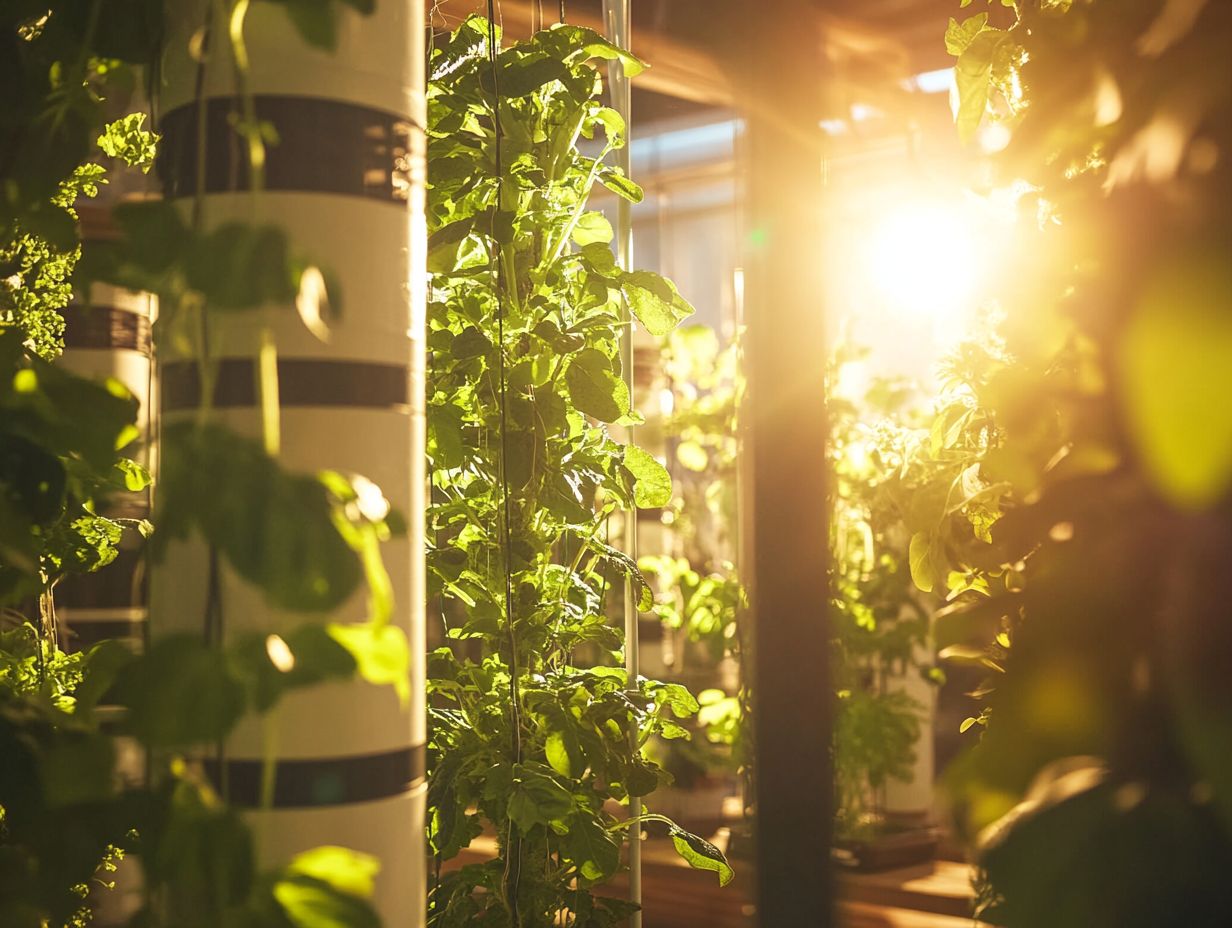
1. Vertical PVC Pipe Garden
The Vertical PVC Pipe Garden presents an innovative solution for urban farming. This method allows you to maximize space in indoor gardening by growing plants upwards to save space.
This compact system enables you to cultivate a variety of vegetables and herbs, such as basil and lettuce. You can efficiently use a water pump and nutrient water to support plant growth in limited areas.
This method conserves precious space while promising a higher yield per square foot. To set up your vertical PVC garden, arrange the pipes in a staggered formation. Ensure that each plant receives ample light an essential factor for their development.
The water pump efficiently recirculates nutrient water through the pipes, delivering hydration to every plant without any waste. Consider plant spacing to avoid overcrowding, which can hinder air circulation and light penetration.
By optimizing these elements, you can effortlessly transform your living space into a lush, green oasis. Start your hydroponic journey today!
2. Mason Jar Herb Garden
A Mason Jar Herb Garden is a delightful addition to your indoor space. It’s a practical way to embrace hydroponics (growing plants without soil) and elevate your culinary game.
This charming setup allows you to grow herbs right in your kitchen. To get started, gather the following essentials:
- Mason jars
- High-quality potting soil or a hydroponic growing medium such as a nutrient-rich solution for optimal growth.
- Plant fertilizer
- Seeds such as basil, mint, or parsley that can thrive in a hydroponic system.
Having basic gardening tools like small trowels and watering cans will make the planting process a breeze. Once your jars are filled with soil and seeds, provide adequate light and water to help your herbs flourish.
The satisfaction of having fresh basil at your fingertips for delicious dishes enhances your meals and promotes sustainable farming by cutting down on the need for store-bought herbs. Share your Mason Jar Herb Garden with us!
3. Window Farming
Window farming transforms your everyday window into a flourishing urban farming oasis using vertical gardening techniques. This method allows you to cultivate a variety of plants indoors, even in spaces with limited sunlight.
Utilize clear aquariums as part of your design. This innovative approach employs hydroponic principles, often using clear aquariums filled with nutrient water to nourish plant cups. For those interested in creating their own setup, check out this guide on how to build a simple hydroponic system, ensuring the roots receive the hydration they need to thrive.
A key element for successful indoor cultivation is optimizing light conditions. Natural sunlight can diminish over time due to dust and obstructions. Incorporate reflective surfaces to enhance light exposure and position your setup to maximize sunlight capture.
Choosing the right plants is essential. Herbs like basil and mint thrive in small spaces, while leafy greens such as lettuce and spinach are perfect companions for window farms, enjoying higher humidity and requiring less direct sunlight.
Get started with your window farm today and share your experiences with us!
4. Hanging Bottle Garden
A Hanging Bottle Garden offers you a creative and sustainable way to maximize your gardening space, making it ideal for urban living. Use vertical farming methods to enhance plant growth and stay eco-friendly.
You can grow your own herbs and vegetables, all while turning discarded containers into stunning green displays. To get started, gather these materials:
- Clear plastic bottles
- Potting soil
- Seeds or seedlings
- Sturdy twine or hooks for hanging
Begin by cutting the bottles in half to create your growing chambers. Ensure you include drainage holes at the bottom for excess water. Secure the halves together, fill them with soil, and plant your chosen flora. For more advanced methods, consider exploring 5 innovative hydroponic growing technologies to enhance your gardening experience.
This method promotes biodiversity and reduces waste. Even the tiniest balconies can host a lush garden, dramatically optimizing your space and enhancing your environmental impact!
5. Wooden Pallet Garden
You can create a Wooden Pallet Garden by repurposing old pallets! It s a brilliant DIY project that promotes sustainable practices.
Start by ensuring your pallet is clean and free of harmful chemicals. Then, apply a protective non-toxic sealant.
Let your creativity shine with various plants like herbs, strawberries, or succulents. They will thrive beautifully thanks to the excellent drainage this design offers.
Arming yourself with tools like gardening gloves, a hammer, and a trowel will streamline the planting process. By embracing reclaimed materials, you’re reducing waste and fostering biodiversity in urban areas!
6. Recycled Plastic Bottle Garden
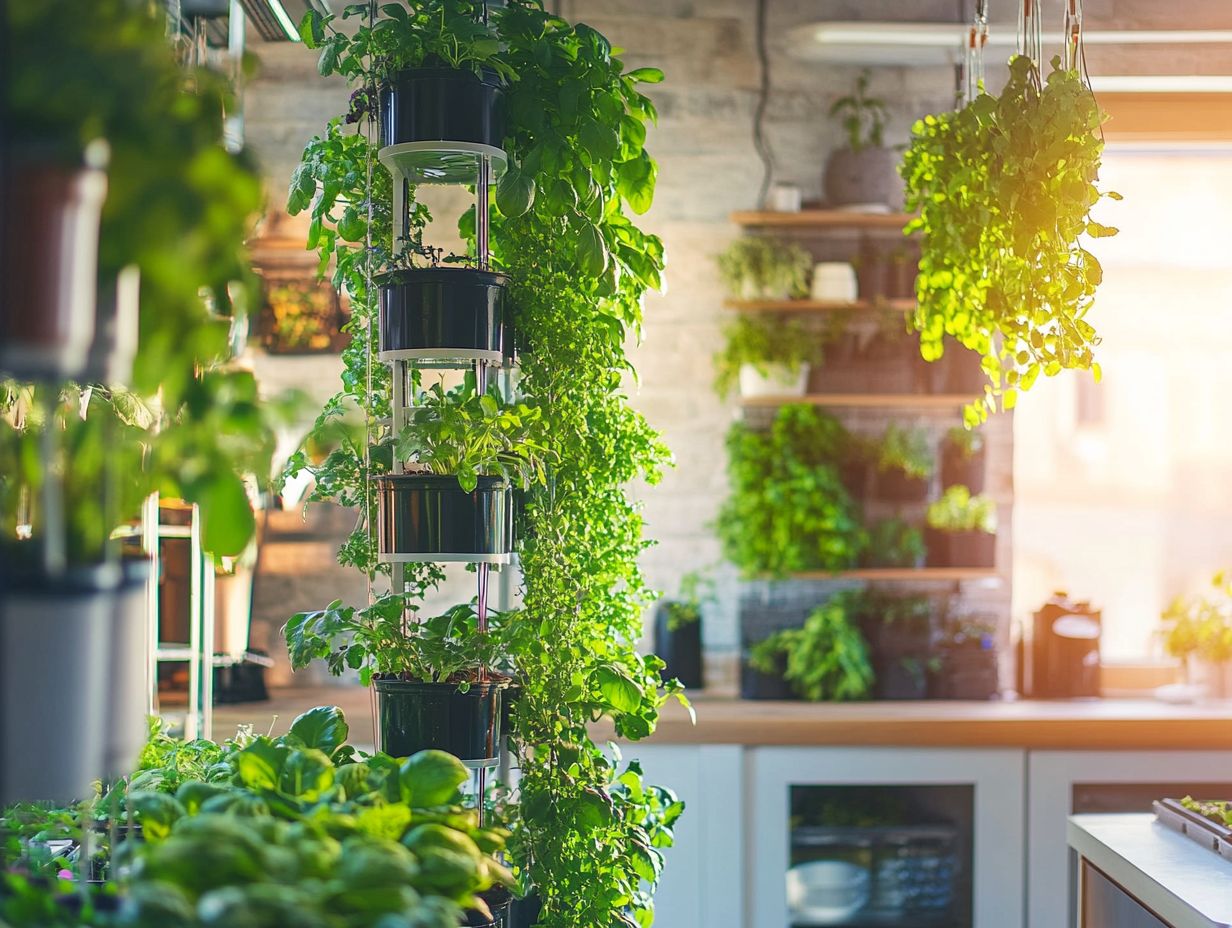
A Recycled Plastic Bottle Garden is a great way to reuse plastic waste! It allows you to engage in sustainable farming while embracing vertical gardening techniques right in your home or community.
This innovative method cuts down on plastic waste piling up in landfills and maximizes limited space in urban settings. By simply cutting bottles in half and hanging or stacking them creatively, you can craft an eye-catching vertical garden that flourishes with minimal soil and water. For more inspiration, check out these 5 creative hydroponic plans for small spaces.
Imagine communities coming together to create these vibrant gardens as a collaborative project! It s a fantastic way to foster social connections while cultivating a shared passion for gardening. This sustainable approach supports local biodiversity and contributes to healthier living!
7. Shoe Organizer Hydroponic System
Turn a shoe organizer into a hydroponic system for efficient indoor gardening! This method is perfect for maximizing plant growth even in the most limited spaces.
This innovative approach doesn’t just optimize vertical space; it allows you to cultivate a delightful array of plants, from leafy greens to vibrant herbs, in the heart of urban living. By utilizing the various pockets of the organizer, you can easily set up a drip irrigation system and refer to 5 creative ways to apply hydroponic nutrients to ensure your plants get just the right amount of water and nutrients.
The benefits of this method go beyond convenience; it significantly reduces water usage, making it a sustainable choice for tight living conditions. Regular checks on nutrient levels and light exposure are crucial for promoting healthier plants and boosting your yields!
Start your gardening adventure now and make an impact!
8. Rotating Tower Garden
The Rotating Tower Garden is an innovative hydroponic solution that allows you to grow a variety of vegetables and greens in a compact, vertical setup. This design maximizes space efficiency and ensures effective nutrient use.
This ingenious gardening system features a rotating mechanism that ensures every plant receives equal sunlight and airflow. This promotes robust growth and prevents overshadowing. By embracing vertical farming principles, you conserve space and simplify plant maintenance.
As the garden rotates, the shifting angles provide better access for maintenance, making watering and harvesting easy. If you’re eager to dive in, DIY plans are readily available, outlining essential materials and construction steps to help you create your own efficient tower. You might also explore 5 unique hydroponic systems to try this year for more innovative ideas.
For ongoing success, regular maintenance tips suggest monitoring nutrient levels and pruning your plants. This enhances air circulation and leads to a flourishing garden with a successful harvest season.
9. Floating Raft System
The Floating Raft System is a highly effective hydroponic gardening technique. It allows you to cultivate plants in a nutrient solution, ensuring robust growth while optimizing crop spacing and light exposure.
This innovative approach uses buoyant rafts made from materials like Styrofoam, which float on a shallow reservoir filled with nutrient-rich water. To set it up, prepare a clean, insulated container filled with water, then add a balanced nutrient solution tailored to your plants’ needs. For those interested in DIY projects, you can learn how to build a simple hydroponic system at home. Regularly monitor pH and nutrient levels to maintain the ideal growing environment.
Leafy greens and herbs, such as lettuce, basil, and spinach, thrive exceptionally well in this system. They enjoy constant access to nutrients and stable moisture, resulting in faster growth rates and higher yields. Embrace this method and watch your garden flourish like never before!
10. Aquaponics System
An aquaponics system combines aquaculture the farming of fish and hydroponics, which means growing plants without soil. This creates a sustainable farming method where both fish and plants thrive together, utilizing a water reservoir filled with nutrient solutions. This method is ideal for urban farmers looking to maximize their space!
This innovative approach taps into the natural synergy between aquatic organisms and terrestrial plants. Fish excrete waste that transforms into essential nutrients through microbial actions. The plants absorb these nutrients, helping them grow strong and healthy while purifying the water before it is recirculated back to the fish tank.
By significantly reducing reliance on synthetic fertilizers and minimizing water usage compared to traditional farming methods, this approach lowers environmental impact and enhances food production efficiency. A well-designed aquaponics system exemplifies a harmonious partnership, enriching modern agricultural practices in a truly remarkable way.
Start your aquaponics journey today and unlock the power of sustainable farming!
How Does Hydroponic Gardening Work?
Hydroponic gardening offers a sophisticated method for growing plants without soil, using nutrient solutions delivered directly to the roots. This method boosts plant growth and saves water, making it an excellent choice for indoor farms and urban environments.
This innovative technique allows for remarkable growth rates while providing precise control over nutrients, ensuring your plants receive exactly what they need for peak health. The irrigation systems in hydroponic setups can vary significantly, from straightforward wick systems to more intricate aeroponic setups, which spray nutrient-rich water onto the roots.
Water reservoirs are essential for maintaining a steady supply of nutrients and oxygen, further promoting plant development. Techniques such as deep water culture, nutrient film technique, and building a vertical hydroponic garden at home demonstrate the versatility of hydroponics, making them ideal for both commercial ventures and passionate home gardening enthusiasts.
What Are the Benefits of DIY Hydroponic Systems?
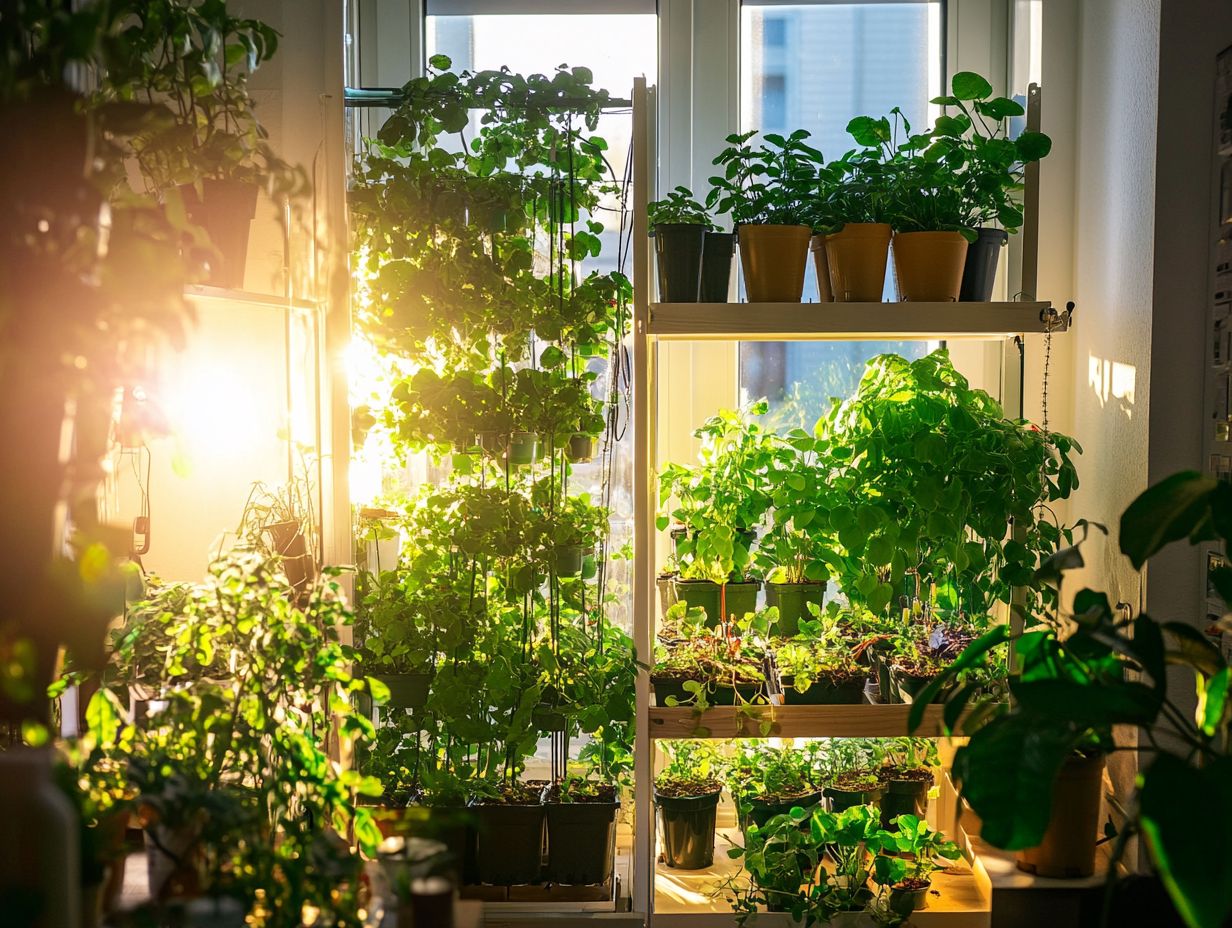
DIY hydroponic systems offer numerous advantages. They allow you to grow fresh produce at home, promote sustainable farming practices, and optimize urban space through clever design structures that support efficient use of space.
These systems provide a continuous supply of fresh herbs and vegetables, helping you cut down on grocery expenses. Many enthusiasts enjoy the joy of growing organic produce without the high prices found in stores.
Take gardening expert Jane Smith, for example she transformed her modest balcony into a flourishing hydroponic haven, highlighting the convenience of having nutrient-rich greens at her fingertips.
These systems help the environment by reducing the carbon footprint linked to food transportation, making DIY hydroponics an appealing choice for eco-conscious gardeners. Consider exploring 5 hydroponic solutions for urban gardening and why not try your hand at growing fresh herbs at home today?
What Materials Do You Need for a DIY Hydroponic System?
Creating your own DIY hydroponic system demands specific materials, including a reliable water pump, a nutrient solution, plant cups, and essential gardening tools. Together, these components create the ideal environment for your plants to thrive, whether in a greenhouse or at home, making it a fulfilling beginner project.
Each component you choose plays a vital role in maintaining a balanced ecosystem for your plants. The water pump circulates the nutrient-rich solution, ensuring that roots receive the hydration and nutrients they need while preventing stagnation. A high-quality nutrient solution, brimming with vitamins and minerals, is fundamental; it provides your plants with the essential resources required for vigorous growth, especially for those in vertical farming setups.
The plant cups serve as sturdy support for your seedlings, allowing their roots to extend into the nutrient solution while ensuring stability. Tools like pH meters and growing trays are crucial for monitoring the system’s health, making your successful gardening endeavors not only possible but also enjoyable.
What Are Some Tips for Maintaining a DIY Hydroponic Garden?
Keep your DIY hydroponic garden thriving with these essential tips for maximizing plant growth and ensuring the longevity of your system. Here are several key tips to follow for success, including proper crop spacing and nutrient monitoring, as well as using a compact system to fit your space.
Regularly monitoring your nutrient solutions is crucial; the right balance of vitamins and minerals can significantly influence your plants’ growth rates. It s also wise to check your irrigation system to ensure it delivers water evenly without overwhelming your plants. Consider implementing a drip irrigation setup (a system that delivers water directly to the roots), which can conserve water while providing consistent moisture.
Maintaining optimal temperature and humidity levels will support the health of your plants. By observing your plants for signs of disease or nutrient deficiency, you can make timely interventions that promote vigorous growth and fruitful yields.
What Are Some Creative Ways to Display Your Hydroponic Garden?
Displaying your hydroponic garden with creativity elevates both its aesthetics and functionality, transforming your indoor farm into a captivating showcase of your gardening finesse. Consider implementing vertical gardening strategies for an eye-catching effect and efficient use of space.
You have a plethora of innovative techniques at your disposal, from maximizing limited space to crafting DIY installations that not only nurture your plants but also serve as stunning focal points in any room.
Consider integrating your hydroponic setup into your home d cor by utilizing stylish shelving units or repurposing materials, ensuring that your garden harmonizes with the overall design theme of your space.
By choosing the right containers and thoughtfully arranging them, you can create an eye-catching display that promotes growth while enhancing the ambiance of your home. For those interested in expanding their gardening skills, consider exploring DIY hydroponic system plans for beginners.
How Can You Customize Your DIY Hydroponic System for Different Plants?
Customizing your DIY hydroponic system for different plants is essential for achieving optimal growth. Each plant has unique requirements for hydroponic nutrients, growing conditions, and crop spacing. You can explore various hydroponic nutrients tailored for specific plants, ensuring they thrive in your setup.
For example, leafy greens like lettuce flourish in cooler temperatures and thrive on a nutrient mix high in nitrogen to support their rapid growth. On the other hand, fruiting plants such as tomatoes prefer warmer conditions and benefit from a well-balanced nutrient mix that includes moderate levels of phosphorus and potassium to boost fruit production.
In terms of plant spacing, adjustments are key. Compact plants can be placed closer together, while larger varieties need more room to spread out. This ensures they receive adequate light and airflow. Understanding these needs can help you create an amazing hydroponic environment!
Frequently Asked Questions
What are hydroponic systems and why are they beneficial for home gardening?
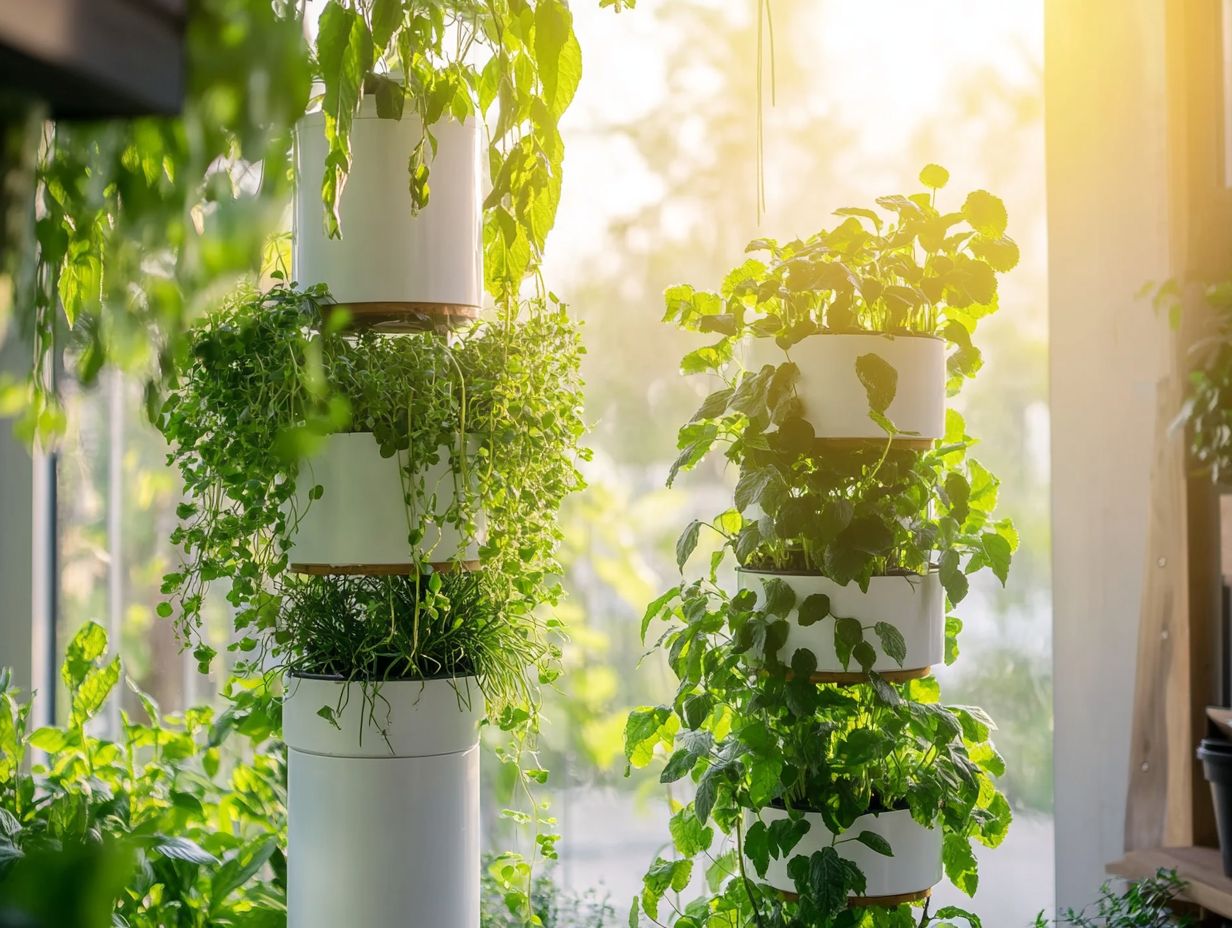
Hydroponic systems are a method of growing plants without soil, using a nutrient-rich solution instead. They are beneficial for home gardening because they allow for year-round growing, use less water, and produce higher yields compared to traditional soil-based methods, which can have a greater environmental impact.
What are some easy DIY hydroponic ideas for beginners?
Some easy DIY hydroponic ideas for beginners include using a mason jar or plastic bottle, creating a vertical garden with PVC pipes, and using a fish tank as a growing container. These projects can inspire creativity and efficiency in indoor gardening and serve as great beginner projects.
What materials do I need to create a simple hydroponic system at home?
To start your hydroponic garden, gather a container like a mason jar or plastic bottle. You ll also need materials for plants, a nutrient solution, and a pump for oxygen.
How can I make my hydroponic system more sustainable?
Transform your hydroponic system into an eco-friendly powerhouse with these simple tips! Use organic nutrients, renewable energy for your pumps, and recycled materials for your containers. These practices help reduce your environmental impact and support sustainable farming.
What are some creative ways to incorporate hydroponics into my home decor?
Get creative! Hang plants in glass bulbs, create a living wall, or use a vintage piece of furniture as a growing container.
Can I grow any type of plant using a hydroponic system?
Absolutely! You can grow a variety of plants, including vegetables, herbs, and fruits. Just research each plant’s needs for success.
Ready to dive into the world of hydroponics? Let s get started today!

